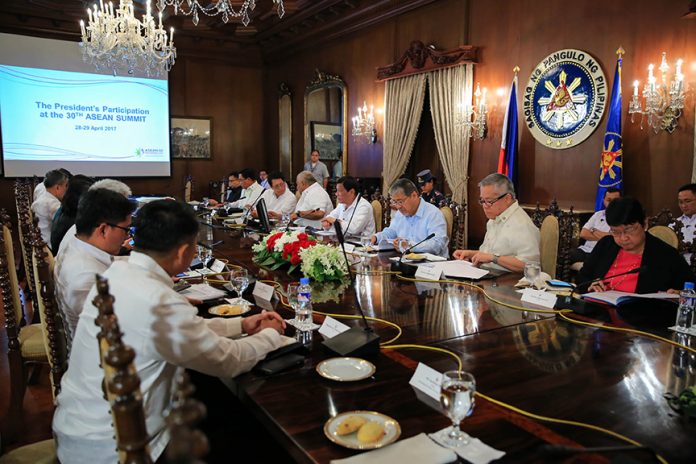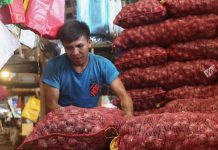
The Heads of States of the Association of South East Asian Nations and their spouses will be feted on Saturday, April 29, to a night of best Filipino cuisine and entertainment at the ASEAN Summit Gala Dinner at the Grand Ballroom of Sofitel Philippine Plaza Manila.
Hosted by President Rodrigo Roa Duterte, the gala dinner, themed “ASEAN Fiesta,” will showcase the Filipinos’ innate warmth and hospitality as a people.
“ASEAN Fiesta,” a post-Summit event, aims to celebrate the Philippines’ cultural diversity and commonality with its ASEAN neighbors. It will display the Philippines’ unique brand of hospitality, art and culture, and outstanding local talents; and will also showcase the commonalities of Filipino heritage with their ASEAN brothers.
An estimated 800 guests composed of the ASEAN heads of states, their spouses, their respective delegations, members of the diplomatic corps, government officials and business leaders are expected to attend the festive occasion, depicting a sense of community, harmony and togetherness.
The ASEAN leaders will wear Mindanao-inspired barong Tagalog by Rajo Laurel, featuring fabric from different Philippine ethno-linguistic tribes.
Their spouses, meanwhile, will be resplendent in their respective Rhett Eala formal wear made from gazar or mikado fabric for the top and crepe fabric for the bottom.
While a sumptuous dinner is being served, guests will be serenaded by a string octet from the Philippine Philharmonic Orchestra.
A cultural presentation will follow. Dubbed as “Golden Weave,” it will consist of four parts beginning with the ASEAN Gold Overture, featuring instrumental solos of indigenous instruments from different ASEAN countries; followed by Post Cards and Songs, introducing world-class Filipino artists singing a mash-up of ASEAN pop hits, well-known standards and current chart-toppers.
The third part will be the Dances, Gongs, and Strings, a graceful cavalcade of Philippine dances from the Cordillera’s dance of the banga to Pangasinan’s wasiwas dance up to the ‘pandanggo sa ilaw’ of the South.
Finally, the Fiesta to cap the event, which will highlight the irresistible beats of the Buganda Drumbeaters, driving home the message of a nation famed for artistry, for its unending fiestas, and for beauty.
Before dinner
Filipinos celebrate milestones through various cultural festivities. Staging a fiesta is one way to honor their important guests.
ASEAN leaders, together with their spouses and delegates, will be treated to various fanfares from start to finish. The program will include native dance and music performances akin in origin and style from other ASEAN cultures.
As the guests arrive at Sofitel, they will be greeted by locals wearing various indigenous garbs and a welcoming music to be rendered by the Citizen’s Brigade Band of Dasmariñas, Cavite. A singkaban arch and festival banners will welcome guests at the hotel driveway.
While they continue to promenade to the cocktail area at Le Bar, the sights and sounds of the Philippines continue to envelop them this time with a rondalla background music.
The mood and texture will change from upbeat to majestic as the guests proceed to the hotel’s grand ballroom where its lobby is adorned with Mindanaoan decor, jewel tones, and intricate detail.
Inside the ballroom, the concept of Philippine fiesta will continue with colorful decor complemented by the merry sounds of the gongs and kulintang ensemble.
Meanwhile, the Romblon Room, served as the holding room for the ASEAN leaders, will showcase the furniture pieces of world-renowned designer Ito Kish.
A photo opportunity with the ASEAN leaders and their spouses donning Mindanao-inspired attire will take place prior to the gala dinner.
The ASEAN Heads of States will be presented with wood trays made of Philippine Mahogany with brass etching.
Three design motifs are prepared, featuring Philippine art and culture: one is the singkil, a folk dance from Maranao; another is a pattern copied from the traditional tapestry called T’nalak of T’bolis from South Cotabato; and the Sarimanok, a legendary bird with colorful feathers said to be a symbol of good fortune.
For their spouses, they will be presented with clear tempered glass cheese plates as tokens.
The tokens come with two design accents: brass kulintang, an ancient instrumental form of music, in nickel plate; and brass Sarimanok in nickel plate. (PNA)






